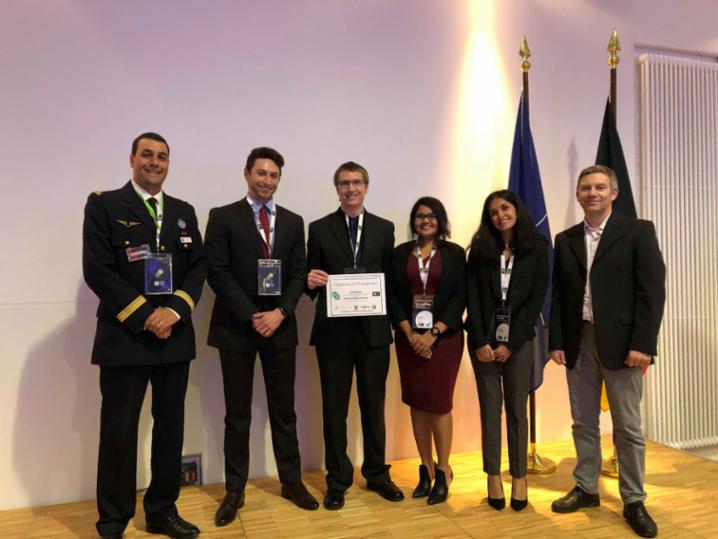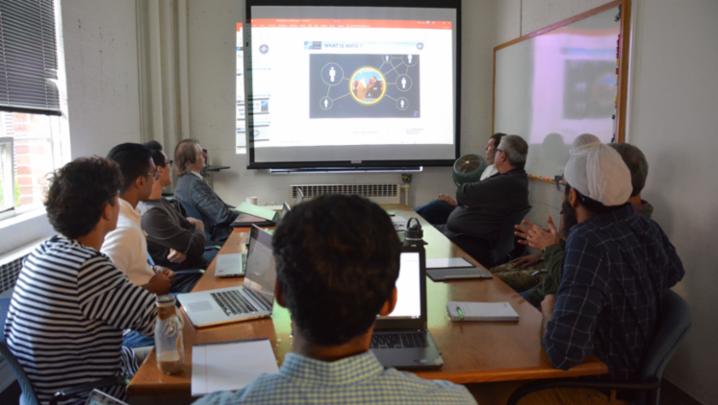Ahead of NATO’s first ever Youth Summit on 9 November 2020, we look at how student engineers and scientists at Johns Hopkins University are contributing to NATO’s quest for innovation, a top priority for the Alliance.
In June 2020, NATO Secretary General Jens Stoltenberg launched the NATO 2030 initiative to “…strengthen the Alliance in an increasingly competitive world. [...] Strong militarily. Stronger politically. And more global.” Part of the initiative includes reaching out to civil society, the private sector and young leaders: “Peace matters, especially for young people, because it’s only by providing peace and freedom, which is the core responsibility of NATO, that young people can decide themselves what kind of life they would like to live….”
At Johns Hopkins University, students have been working with the Innovation Hub at Allied Command Transformation (ACT), in Norfolk, Virginia, and the Innovation Unit of the Emerging Security Challenges Division at NATO Headquarters, in Brussels, for almost two years. None of these students has a military or security background. They are young undergraduate and graduate students (in their late teens and early 20s) in a wide range of studies – many in the university’s Whiting School of Engineering.
We began collaborating with NATO, when a student innovation team working on ideas for airborne drone defence, presented their findings at the NATO Countering Unmanned Systems Innovation Challenge held in Berlin, Germany, on 12 November 2018. While that invitation came through a set of fortuitous events, the relationships created there led to discussions of how best to engage university students with the Alliance. The simple answer was to give them problems – ones that appeal specifically to the interests and concerns of university students.

A student innovation team presented their design for a drone-neutralizing system at the November 2018 NATO Countering Unmanned Systems Innovation Challenge held in Berlin, Germany. Photo courtesy of Johns Hopkins University
Approach to problems
At Johns Hopkins, we have developed a model that categorises problems according to their level of “definition”. We have called them “well-defined”, “ill-defined” and “un-defined”. Different kinds of problems require different kinds of thinking and different kinds of tools – and in a university setting, different kinds of events, conferences, projects, and classes.
Well-defined problems typically have clear requirements and clear solutions, even if the solutions are hard to find. For example, integrating previously unlinked datasets to provide a holistic and detailed geospatial map.
Ill-defined problems typically ask, “what’s next for us, what problem is there worth solving?” For example, can we develop tools to help young people recognise the difference between false information and the truth?
By contrast, un-defined problems typically involve scenario planning and ask, “what kinds of problems might we find in the future, over the horizon?” For example, what is cognitive warfare and how might it affect our democracies and freedoms over the next twenty years?
The three problem categories of this model are related. Un-defined problems give rise to scenarios that can then be explored to identify actions that can be taken today to prepare against either all scenarios or any specific one. This, in turn, gives rise to the need to further explore specific domains to define problems that are worth solving.
Scenarios cannot be “solved,” only explored. And the same can be said for ill-defined problems, which represent domains to be explored to find well-defined problems that are worth solving. All require speaking to external experts and relevant people. But, at the end of the day, only problems that are well-defined and clearly delineated can be solved. All three kinds of problems have a place in a university curriculum focused on building skills among students.
It is important to understand that the “flow” of problems can go both ways. Scenario analysis can lead to domain exploration, which should lead to careful problem definition and a solution. On the other hand, a radical solution to a well-defined problem can identify domains that are worth further exploration, which in turn can uncover vistas on a very different future that can best be grappled with through scenarios.

Johns Hopkins University has developed a specific approach to building problem-solving skills among students. Photo courtesy of Johns Hopkins University
Our students are using this problem-defining approach in several ongoing NATO projects, each of which has the potential for wide-ranging usefulness to the Alliance:
Well-defined
In the “well defined” category, a computer science team worked on the specific technical problem of linking three data sets – Open Street Map, Wikidata and GEOnet Names Server – to provide detailed information about geographic locations to users in an integrated platform.
Ill-defined
Several teams worked on ill-defined problems, which have led to better-defined problem formulations:
An innovation and design team took on the task of rethinking combat medicine. After discussions with experts, including medical staff at the Medical Branch of ACT, in the US military and at Johns Hopkins Hospital, the students decided to focus on the need for improving casualty survival rates in battlefield and civilian mass casualty scenarios. This effort led to the more well-defined problem of designing and building an artificial intelligence-based medical triage assistant. The team will be joined on the project this year by students from the Czech Technical University in Prague, all working remotely.
A strategy team explored Cognitive Biotechnological Advancements. The team reviewed current research and emerging technologies to create scenarios of the use of these advancements – and their potential impact on NATO operations. The next step is to understand which avenues of research are most likely to bear fruit for the Alliance.
One team worked on a problem that initially appeared “well-defined” but the research uncovered additional unanticipated problem areas. This technical advisory team is working for NATO's DTEx (Disruptive Tech Experiment), sponsored by ACT's Innovation Hub, that will select technological solutions to identify and mitigate the spread of false information. In the course of their extensive research on these technologies, the team identified several entirely unaddressed scenarios and needs – thereby expanding the scope of the inquiry. The effort will provide a basis for NATO to better analyse technology investment options and to build a strategy to stop the harmful effects of fake news.
Un-defined
Another strategy team worked on the “un-defined” problem of Cognitive Warfare. The team focused on defining the topic, exploring its contours, possible goals and general methods. The team reviewed the literature and distinguished it from other types of psychological operations (for example, more traditional attempts at creating false information to mislead the enemy as to the points of attack; radio broadcasts into enemy territory to influence public opinion; or dropping leaflets to influence enemy soldier morale). Their next step is to understand how a nation can best determine – and, possibly, measure and track – whether it is under cognitive attack.
These teams consist of undergraduate and graduate students. All teams presented their findings to their NATO sponsors – ACT’s Innovation Hub and NATO’s Innovation Unit – and are now defining further objectives. The good news is that all students are eager to continue with their projects. They feel that the projects were interesting and contributed to solving important problems – not just for the NATO Alliance and political leadership – but also for the students in their own lives.
To date, we have seen two important outcomes. First, students have come up with some interesting and innovative solutions to the challenges that NATO has presented them. Second, the students have developed a real appreciation for NATO, the issues it faces, and the important role that it plays in preserving peace and democratic values. In fact, some have paid NATO their generation’s highest compliment: “it is so cool.” Perhaps such engagement is, as per the Secretary General’s words, the most important outcome of our efforts – an increased awareness of NATO and its relevance to the lives of young people.
The students come up with some amazing ideas. Their university work on biotechnologies and tracking supply chains has been hugely insightful and creative.
We believe that this cooperation between Johns Hopkins and NATO will continue to bear fruit. As a result of our efforts to date, the high-level goals of this kind of collaboration are becoming much clearer:
For students, good projects
For NATO, exposure to different kinds of thinking and (ideally) innovative solutions
For both, better relationships
And, just maybe, something real will come out of it
Leveraging the Alliance’s advantages
One of the great advantages that NATO offers is the ability to think big about problems that will only grow in importance. The role of a research university like Johns Hopkins is to provide useful perspectives and solutions to these problems. In a recent article in NATO Review, “Building a Resilient Innovation Pipeline for the Alliance”, Rob Murray notes the importance of leveraging the Alliance’s “abundance of world-class academic institutions, the finest scientific researchers, amazingly creative start-ups and a mature well-resourced financial eco-system.” We hope to play a role in this effort.
Our objective now is to expand this kind of cooperation to other universities (a first attempt at this is our plan to work with the Czech Technical University on the combat medicine project mentioned above) and create something of a “global consortium” of schools, academics and researchers that want to work together on these kinds of problems. Working globally can extend the range and diversity of thinking on these challenges and apply student researchers to the most pressing issues, as well as increasing the number of young people with a deep, and growing, appreciation for NATO and its work.

